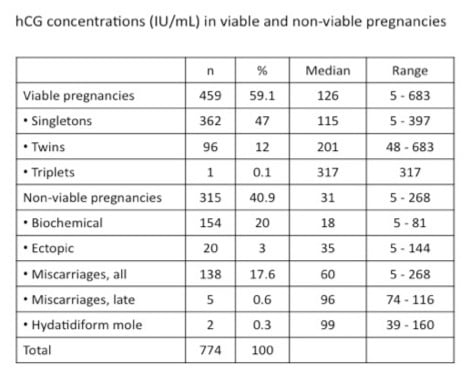
 So you're in the IVF process, and now you’ve waited the long 10-16 days for your first pregnancy test. Your hCG level comes back positive. Congratulations!
So you're in the IVF process, and now you’ve waited the long 10-16 days for your first pregnancy test. Your hCG level comes back positive. Congratulations!
Then the panic sets in. Is my number too low? Is it too high? Does this mean I'm having twins? Triplets? At InVia Fertility, we often have patients ask us to interpret their hCG level from that first positive test—and the truth is, most of the time that's not possible.
hCG (Human Chorionic Gonadotropin) is the “pregnancy hormone." It is detected soon after implantation and typically doubles every 72 hours. It reaches its peak by 8-11 weeks of pregnancy and levels off. An hCG level under 5 is considered negative. Between 5 and 25 is considered a low positive and can alert the provider to an abnormal pregnancy (i.e., chemical or ectopic). Over 25 is considered a positive hCG level for pregnancy.
This being said, a single hCG level does not provide much information. It's necessary to take repeat serum (blood) levels to see if the level is decreasing or rising appropriately. Once the hCG level has reached approximately 1,000, a transvaginal ultrasound should be able to detect a gestational sac in the uterus. After that point, serial ultrasounds will provide the most important information for your fertility specialist.
The chart below provides median hCG levels, but also a range. As you can see, the range varies significantly:

The range for singletons is 5 – 397 and for twins it is 48 – 683. As you can see, there is a big overlap between the first hCG level in singleton and twins. What this means is that even if you have a first hCG level of 397, it could be a singleton pregnancy. Also, if the first hCG level is 48; it could still be a twin pregnancy. Thus, a single hCG level cannot distinguish between a singleton and a twin pregnancy. Of course, if the first hCG level is say, 1200 mIU/mL; it is most like a multiple pregnancy — but you cannot be sure till the ultrasound a couple of weeks later.
A similar observation can be made when it comes to miscarriage. Here, the first hCG level range is from 5 – 268. Thus, even patients with (an excellent) first hCG level of 268 mIU/mL can miscarry.
Finally, your hCG level can be affected by whether you had a day 5 or day 3 embryo transfer.
So, to summarize: when the first hCG test is positive, it's great news—you've overcome a huge hurdle, and it's okay to enjoy the moment! You are indeed pregnant! However, it may be prudent to remember that the follow up hCG levels have to show appropriate increase, and subsequent ultrasounds have to show appropriate growth, before it's possible to confirm that it is an ongoing pregnancy.
The hCG levels above are only guidelines. There are always exceptions to the rule. This is why, even if the hCG levels are low, it is important to continue the medications and keep follow up monitoring appointments.
To work with a qualified, board-certified fertility specialist, make an appointment at one of InVia’s four Chicago area fertility clinics.

Entire Website © 2003 - 2020
Karande and Associates d/b/a InVia
Fertility Specialists
